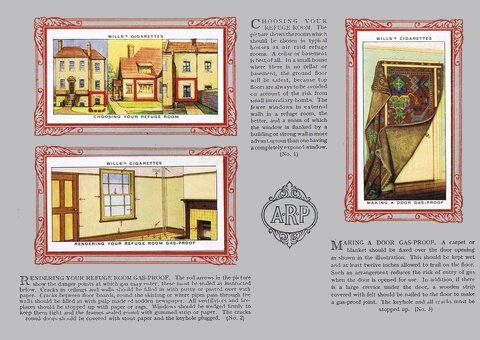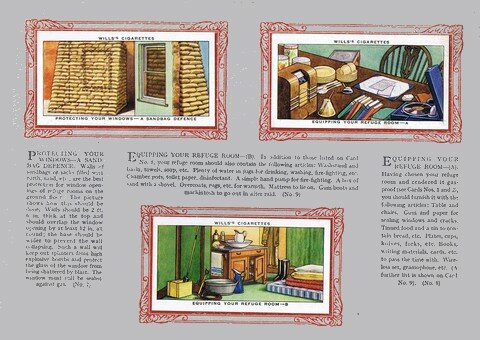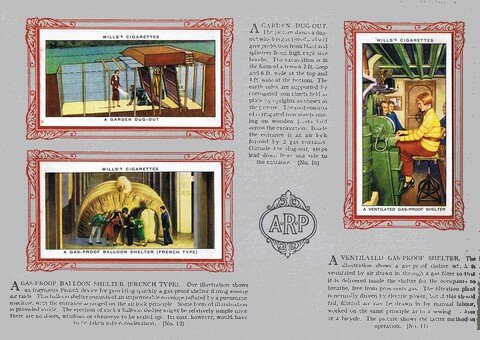Cigarette Cards
Air Raid Precautions 1938


Foreword by the Home Secretary
Home Office, Whitehall, London, S.W.1
This series of A.R.P. cigarette cards shows in clear pictures some of the things that the Government and the Local Authorities are working out for the protection of the general public, and also some of the things that each member of the public can do for himself in time of emergency. As Home Secretary I am responsible for a Home Defence Service which might affect the life of any person in the country, and I therefore welcome these cigarette cards for the manner in which they bring home to the householder and his family what they can do for themselves. Air Raid Precautions are not mysterious. They are based on commonsense suggestions and the essential things recommended cost very little and demand ingenuity and improvisation rather than expenditure. Even some of the more elaborate recommendations can be carried out quite easily in co-operation with a neighbour. I commend a study of these cards to your attention.
Samuel Hoare

CHOOSING YOUR REFUGE ROOM. The picture shows the rooms which should be chosen in typical houses as air raid refuge rooms. A cellar or basement is best of all. In a small house where there is no cellar or basement, the ground floor will be safest, because top floors are always to be avoided on account of the risk from small incendiary bombs. The fewer windows in external walls in a refuge room, the better, and a room of which the window is flanked by a building or strong wall is more advantageous than one having a completely exposed window. (No.1)
RENDERING YOUR REFUGE ROOM GAS-PROOF. The red arrows in the picture show the danger points at which gas may enter; these must be sealed as instructed below. Cracks in ceilings and walls should be filled in with putty or pasted over with paper. Cracks between floor boards, round the skirting or where pipes pass through the walls should be filled in with pulp made of sodden newspaper. All ventilators and fireplaces should be stopped up with paper or rags. Windows should be wedged firmly to keep them tight and the frames sealed round with gummed strip or paper. The cracks round doors should be covered with stout paper and the keyhole plugged. (No.2)
MAKING A DOOR GAS-PROOF. A carpet or blanket should be fixed over the door opening as shown in the illustration. This should be kept wet and at least twelve inches allowed to trail on the floor. Such an arrangement reduces the risk of entry of gas when the door is opened for use. In addition, if there is a large crevice under the door, a wooden strip covered with felt should be nailed to the floor to make a gas-proof joint. The keyhole and all cracks must be stopped up. (No.3)

WINDOW PROTECTION. This illustration shows three methods of preventing fragments of glass flying into a room when the window is damaged by bomb explosion. (A) By two layers of transparent wrapping material gummed all over the inside of the glass. This admits light. (B) By mosquito netting gummed on the glass. (C) By stout paper pasted on the glass. Should the glass be completely shattered, then attach by means of thumbscrews to the inside of the of the window, a frame (D) in which there are two thicknesses of blanket with 1/2inch mesh wire netting on each side. Another simple method is represented by a curtain (E) which is let down and fixed round the edges by strips of wood nailed to the window frame. (No.4)
WINDOW PROTECTION AGAINST BLAST. Ordinary glass may be shattered by the blast effects of high explosive bombs, but there are various substitutes for ordinary glass which are more resistant. The left-hand panes in the picture are of a specially strengthened glass and the right-hand panes are of non-inflammable transparent celluloid 1/10inch thick, reinforced on the inside by 1/2 inch mesh wire netting. Both offer considerable resistance to blast pressure, although they may be penetrated by steel splinters from bombs. If this should occur, the holes and cracks in the damaged pane should at once be pasted over with stout paper to make the pane gas-proof. (No.5)
TYPES OF SPLINTER-PROOF WALL. In the event of an air raid, steel splinters and fragments from high explosive bombs may cause many casualties. It is therefore important to take protective measures against such fragments. The picture shows three types of wall (including methods of improvisation) which will afford protection. The first (right) is of brick 13½ inches thick. The second (centre) consists of broken brick, rubble or shingle 2feet thick between corrugated iron sheets. The third (left) consists of these materials in boxes. (No.6)

PROTECTING YOUR WALLS - A SANDBAG DEFENCE. Walls of sandbags or sacks filled with earth, sand, etc., are the best protection for window openings of refuge rooms on the ground floor. The picture shows how this should be done. Walls should be 2ft 6in thick at the top and should overlap the window opening by at least 12inches all round; the base should be wider to prevent the wall collapsing. Such a wall will keep out splinters from high explosive bombs and protect the glass of the window from being shattered by blast. The window must still be sealed against gas. (No.7)
EQUIPPING YOUR REFUGE ROOM . (A) Having chosen your refuge room and rendered it gas-proof (see Cards Nos. 1 and 2), you should furnish it with the following articles: Table and chairs. Gum and paper for sealing windows and cracks. Tinned food and a tin to contain bread, etc. Plates, cups, knives, forks, etc. Books, writing materials, cards, etc. to pass the time with. Wireless set, gramophone, etc. (A further list is shown on Card No. 9). (No.8)
EQUIPPING YOUR REFUGE ROOM . (B) In addition to those listed on Card No. 8, your refuge room should also contain the following articles: Washstand and basin, towels, soap, etc. Plenty of water in jugs for drinking, washing, fire-fighting etc. Chamber pots, toilet paper, disinfectant. A simple hand pump for fire-fighting. A box of sand with a shovel. Overcoats, rugs, etc. for warmth. Mattress to lie on. Gum boots and mackintosh to go out in after raid. (No.9)

A GARDEN DUG-OUT. The picture shows a dug-out which is gas-proof and will give protection from blast and splinters from high explosive bombs. The excavation is in the form of a trench 7 ft. deep and 6 ft. wide at the top and 4 ft. wide at the bottom. The earth sides are supported by corrugated iron sheets held in place by uprights as shown in the picture. The roof consists of corrugated iron sheets resting on wooden joists laid across the excavation. Inside the entrance is an air lock formed by 2 gas curtains. Outside the dug-out, steps lead down from one side to the entrance. (No.10)
A VENTILATED GAS-PROOF SHELTER. The illustration shows a gas-proof shelter which is ventilated by air drawn in through a gas filter so that it is delivered inside the shelter for the occupants to breathe, free from poisonous gas. The filtration plant is normally driven by electric power, but if this should fail, filtered air can be drawn in by manual labour worked on the same principle as in a sewing machine or a bicycle. The picture shows the latter method in operation. (No.11)
A GAS-PROOF BALLOON SHELTER (FRENCH TYPE). Our illustration shows an ingenious French device for providing quickly a gas-proof shelter during enemy air raids. This balloon shelter consists of an impermeable envelope inflated by a pneumatic machine, with the entrance arranged on the air lock principle. Some form of illumination is provided inside. The erection of such a balloon shelter might be relatively simple since there are no doors, windows or chimneys to be sealed up. Its cost, however, would have to be taken into consideration. (No.12)

INCENDIARY BOMB AND ITS EFFECT. (Fire started in Room). The 2 lb. magnesium bomb does not explode, its only object being to start a fire. It will probably penetrate no further than the attic or an upper floor, setting light to anything within a few feet. Vast numbers of these light bombs can be carried by a single aeroplane, and many more fires started than could be dealt with by fire brigades. Householders, with a little training and equipment, can deal with the incendiary bombs and so protect their homes and defeat the enemy's object. Instructions on how to deal with these bombs are given on Cards Nos 14 to 17. (No.13)
INCENDIARY BOMB COOLING DOWN. (Preliminary Fire Extinguishing with Jet from Stirrup Hand Pump). Much damage may be caused in an air raid by light incendiary bombs. The intense heat and smoke from such a bomb and the fire which it will have started make close approach impossible until the atmosphere has been cooled down and the fire partly extinguished. This is done with a jet of water from a hose not less than 30 ft. long. The stirrup hand pump (illustrated and described on Card No. 18) is recommended for this purpose. The girl in the picture is kneeling, as smoke is not so thick close to the ground. Note Redhill container in foreground (see Card No. 17). (No.14)
CONTROL OF INCENDIARY BOMB . (Pouring on Sand from Scoop). The method of dealing with incendiary bombs is described on Cards Nos. 13 to 17. In this picture the girl has taken sand from the container and is pouring it on to the bomb with a long-handled scoop. Sand does not extinguish the magnesium bomb, but it controls it and reduces the heat, thus allowing near approach. Note the Redhill container (described on Card No.17) placed on its side in a way that full scoopfuls of sand can easily be withdrawn. After the first scoopful of sand has been placed on the bomb, the glare and heat are greatly reduced. (No.15)
« Index
